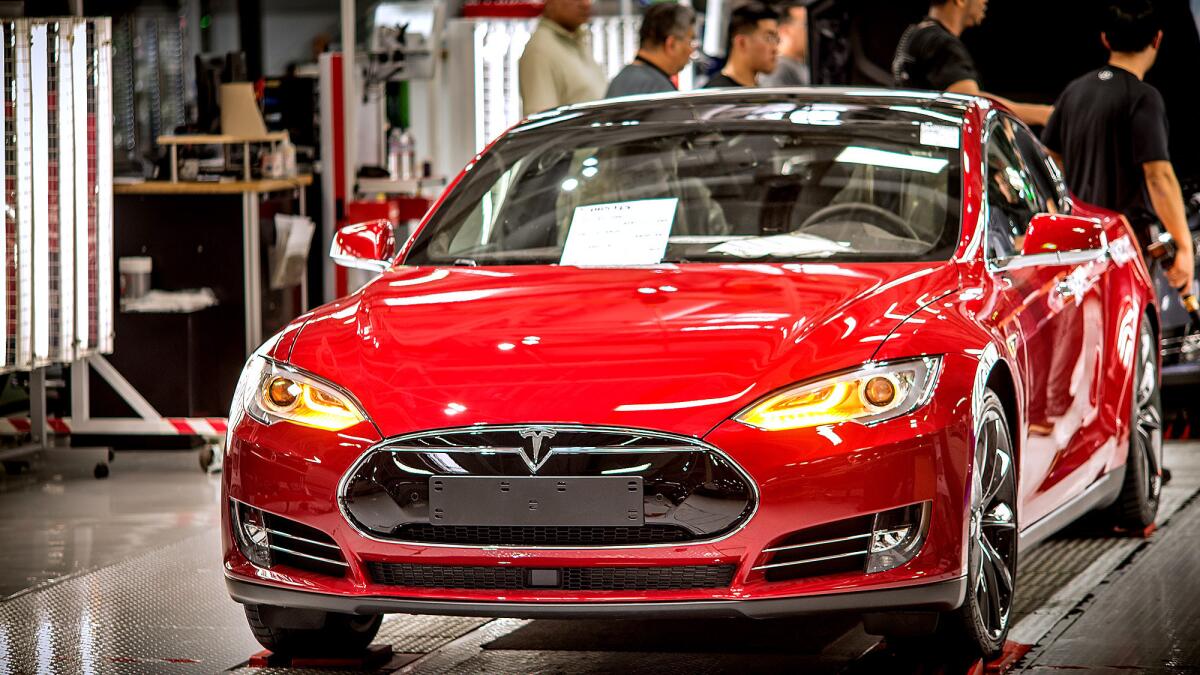Tesla stock plunges after it posts $108-million quarterly loss

Tesla Motors Inc. continued to report big losses as it invests heavily in factories and new models to solidify its growth.
The Palo Alto electric car company reported a loss of $107.6 million in the fourth quarter, up from a loss of $16.3 million in the same period a year earlier. For all of last year, Tesla lost $294 million compared with $74 million in the prior year.
Tesla’s revenue continues to soar, however, jumping 56% for the quarter to $956.7 million and 59% to $3.2 billion for the year. The growth reflects its ramping up production of its Model S sport sedan to tap overseas markets. The Model S has an average sales price of about $100,000.
Tesla Chief Executive Elon Musk blamed the losses on a “delivery shortfall” caused by several factors.
Severe winter weather and shipping problems delayed the delivery of about 1,400 vehicles into this quarter. The company also encountered problems getting the new, dual-motor, all-wheel-drive version of the Model S to market, along with glitches in the development of automated driver assistance features.
Like other domestic automakers, Tesla’s financial results were hurt by the impact of the strong value of the dollar, which reduces foreign profits.
Overall, the results “look like a miss for the quarter,” said Efraim Levy, who follows the auto industry for S&P Capital IQ.
Levy said Tesla fell short on investor expectations for both revenue and earnings.
Tesla shares fell $3.49, or 1.6%, to $212.80 on Wednesday, before the release of its financial results. The shares fell an additional 4% to $205 after the disclosure.
The stock now trades 28% below its high of $286.04, reached in early September.
Investors didn’t like Tesla missing most of its targets in the fourth quarter, said Karl Brauer, senior analyst at auto information company Kelley Blue Book.
“It was close on vehicle deliveries but revenue and earnings were off by a wide margin,” Brauer said. “This puts Elon Musk under greater pressure to deliver in 2015.”
Tesla’s results looked better on an operating basis, in which the automaker counts deferred revenue from a special car sales program that’s similar to a lease. It also excludes certain interest and compensation expenses.
On that basis, the automaker said it posted a $16.2-million loss for the quarter, compared with a $45.9-million profit a year earlier. Its $20-million profit for the year compares to a $103.6-million operating profit in 2013.
As in previous quarters, Tesla continues to make money from selling special California and other environmental credits to other automakers, which need them to meet government mandates. Tesla made about $86 million selling the credits in the fourth quarter.
Levy noted that Tesla’s outlook for this year continues to be optimistic.
The company expects to deliver about 55,000 Model S and X vehicles, representing more than a 70% increase over 2014 deliveries.
But for that to happen, everything must go right for the company, Brauer said, including “a perfect launch of the Model X,” which already has been delayed several times.
The Model X is a new electric SUV that Tesla expects to start selling in the third quarter. The automaker said sales will be weighted to the second half of the year because it needs to reduce production in the second quarter to retool factories.
Tesla said it has more than 10,000 orders for the Model S and almost 20,000 reservations for Model X.
The automaker has a variety of endeavors that are sucking up cash. Musk said he anticipates $1.5 billion in capital spending this year.
The company is purchasing equipment and configuring its Fremont, Calif., factory so that it can begin production of the seven-seat Model X.
Tesla is also starting to develop its Model 3, a small electric car that will sell in the $30,000 price range, after federal and state tax incentives for electric car buyers.
Tesla has said it could start selling its Model 3 by 2017, but it will take several years for production to ramp up to the hundreds of thousands of cars Musk wants to sell.
The car is expected to quickly become the automaker’s bestseller because of its lower price.
Tesla will need the higher-volume model for the company to become fully profitable by 2020, Musk said at an automotive industry conference in Detroit last month. He has set a goal of 500,000 vehicles sales by 2020 and “several million” by 2025.
Last year, Tesla sold 18,750 cars in the U.S. last year, down 3% from the prior year, according to an Autodata Inc. estimate. But the company continues to grow rapidly overseas.
But more established automakers could pose a competitive threat.
Detroit giant General Motors will have its new electric Bolt in production by 2017. The car is expected to have a range of 200 miles — more than double most affordable electric cars today — and sell for a price similar to what Tesla promises for the Model 3.
Nissan, meanwhile, is designing a second-generation Leaf electric car that is expected to have a much longer driving range than the current car’s 84 miles.
Tesla also has started construction of its $5-billion “gigafactory” at the Tahoe Reno Industrial Center near Sparks, in northern Nevada, where it will produce batteries in partnership with Japanese electronics giant Panasonic. Tesla says it needs the giant factory to produce the millions of battery cells needed for the Model 3 and its other cars.
That will be crucial to keep the price of the Model 3 competitive, Musk said.
Follow me on Twitter (@LATimesJerry), Facebook and Google+.







